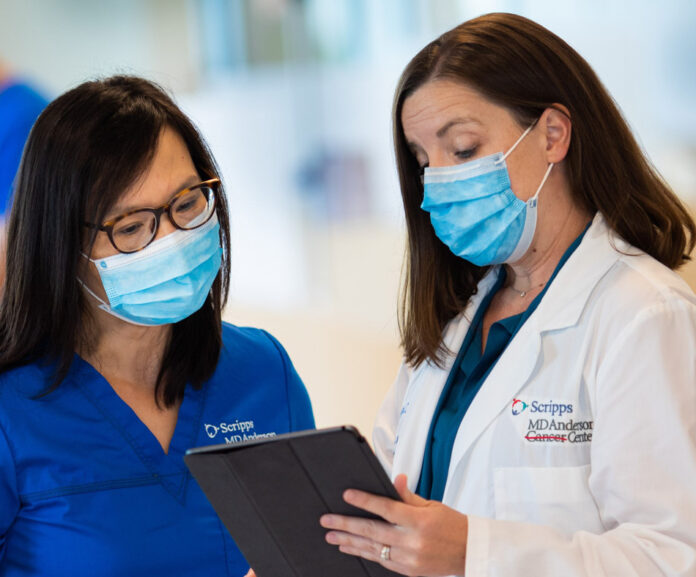
Located at Scripps Mercy Hospital in Hillcrest, the newly opened $59 million Prebys Cancer Center is part of the MD Anderson Cancer Center program, and is Scripps’ first comprehensive cancer center serving central, east, and south county San Diego. With October being Breast Cancer Awareness Month, Dr. Carrie Costantini, breast medical oncologist at Scripps MD Anderson Cancer Center and a Scripps Clinic physician said the new center is a hub with clinics that bring all the physicians together to help women with breast cancer and other cancers.
“A woman diagnosed with breast cancer can come in upon learning her diagnosis, then gets navigated by one of our nurse navigators, help answer any questions and set up appointments,” she said. “She will come in and meet her surgeon, her radiation and medical oncologists, all at the same time. That allows us to be able to focus on our different parts in her treatment and answer all the questions that understandably come with a breast cancer diagnosis, make a treatment plan and get started on it in a prompt fashion.”
Prebys Cancer Center is the new outpatient facility that just opened last month on the campus of Scripps Mercy Hospital San Diego. It is a standalone facility across from the main hospital, and is an outpatient facility, meaning no overnight stays. It is a comprehensive cancer center that offers day treatments such as radiation therapy, infusion of chemotherapy, immunotherapy, targeted therapy, and minor cancer surgery procedures, as well as multi-disciplinary clinics and consultations. Costantini said around 280,000 breast cancer diagnoses are predicted for 2021. While advances remain significant in breast cancer, there is still unfortunately around 43,000 deaths per year.
“Breast cancer is diagnosed through screenings through mammograms, a widely available tool shown to detect cancers early and help save lives. If detected early, meaning localized to the breasts, breast cancer is very treatable, and highly effective treatment resulting in survival rates is above the 90% success rate at five years, which is amazing,” she said.
Costantini said it uses different medications and treatments for breast cancer, and breast cancer is treated in a multi-disciplinary fashion, meaning with a breast surgeon, a medical oncologist, as well a radiation oncologist
“My role as a medical oncologist is to help captain the ship with the patient,” she said. “We work together to ensure that all the aspects of her care are being cared for. Our surgeons do the primary treatment with surgery, then our radiation oncologist will do radiation therapy after surgery in many circumstances to help reduce the risk of the cancer coming back in the breast itself. My role as the medical oncologist is to discuss medications, both what we call systemic therapy, which involves things like chemotherapy, or targeted agents, or immune therapy, with anti-estrogen, anti-hormonal therapy. All this work together helps reduce the risks of patient’s breast cancer coming back.”
Costantini said in the past couple of months, there have been two new advances in breast cancer treatment. Keytruda, an immunotherapy approved for high-risk breast cancer manipulates the immune system so that the immune system can see the cancer and fight it.
“When we combine it with chemotherapy before a woman has surgery in a very specific subset of cancer called a triple-negative breast cancer. A breast cancer that is not sensitive to estrogen, progesterone, or a protein called HER-2,” she said. “A recent study showed that if you add it to the chemotherapy before surgery, it can approve outcomes. We have a better chance of treating the cancer and people do better. It is in early studies, so they are still following women for their survival long term, but thus far, it is looking very promising in reducing the cancer coming back.”
Keytruda has already been approved for numerous other cancers such as lung, head and neck, stomach, melanoma, and Hodgkin lymphoma. This is the first immunotherapy approval for early-stage breast cancer.
New data from a global clinical trial presented in September 2021 showed that a targeted therapy called ENHERTU was twice as effective as the existing standard of care in controlling HER-2 positive breast cancer, an especially aggressive disease. Results from the randomized clinical trial for advanced or metastatic HER-2 positive breast cancer revealed that fewer than 25% of patients treated with ENHERTU showed disease progression or death after 12 months of treatment, compared to 65% of patients treated with the standard-of-care therapy. The study results could open the door for ENHERTU to become the new standard of care for patients with HER-2 positive metastatic breast cancer following their initial therapy.
“The cancer has hiding mechanisms and is hiding from a patient’s immune system,” said Costantini. “These medicines go in and remove these cancer hiding mechanisms so that the cancer is visible to the immune system, which can recognize that it is being abnormal and go and attack it.”
Costantini said screening mammograms work, they are safe, and they are effective.
“They truly do not hurt which I know is a common misconception of some women,” she said. “And you can find these cancers early and that is what we really want. We want to cure women of these cancers without all these chemotherapies and other medications. We have them if we need them, and that is amazing, but if we can catch these early, I tell women that this can just be a bump in the road for them. We will keep an eye on it, but we will catch it early, treat it, and get you back to all the things that you are doing.”
Costantini said she is excited to have this new regional hub open for patients to seek comprehensive cancer care. She said in the past, women would have to go to Torrey Pines Mesa for radiation therapy, but no longer must do that.
“They can get treated very conveniently, closer to home, in the same place where they will see their doctors. And if they need chemotherapy and other medications, they can receive all of it in one place,” she said.
Costantini said the Center has a variety of insurers, and programs to treat patients who may need additional support.
“At this campus, we do see underserved patients with MediCal and other insurances. We involve our financial counselors to figure it out, but if someone calls 1-800-SCRIPPS, we have the resources to help a woman, or any patients, to determine whether they can receive care from us,” she said.
American Cancer Society reports:
• Estimated new cases of breast cancer in the U.S. in 2021 – 281,550
• Breast cancer is the most common cancer in American women, except for skin cancers.
• The average risk of a woman in the United States developing breast cancer sometime in her life is about 13%.
• Estimated deaths from breast cancer in the U.S. in 2021 – 43,600
• Breast cancer is the second-leading cause of cancer death in women in the U.S. Only lung cancer kills more women each year.
• At this time there are more than 3.8 million breast cancer survivors in the U.S.
Five-year relative survival rates for breast cancer are as follows (based on women diagnosed between 2010 and 2016):
• Localized – 99% five year relative survival rate
• Regional – 86% five year relative survival rate
• Distant – 28% five year relative survival rate
• All stages combined – 90% five year relative survival rate.
CORRECTION: Because of a typographical error a previous version of this story incorrectly stated the cost of the new facility and the number of cancer deaths. The newly opened facility cost $59 million, not $56 million, and the number of breast cancer deaths are 43,000 rather than 3,000. The East County Californian regrets the error.













